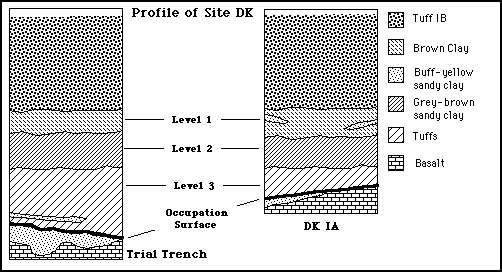
Click on the stratum key at right for more information about each stratum.

This page provides you with information on the stratigraphy of Site DK at Olduvai Gorge. In general, the deposits have been so heavily reworked and moved about by subsequent stream action, that they have been treated as a single depositional period. It is evident that the material was laid down during a period of significant rainfall, at a time when the lake level was still fairly high, giving rise to swampy areas such as this one was. It would have been a good location for traping medium to large game in the soft river and lake muds. Substantial deposits of large antelope bone and remains of other animals internedded with stone tools lends some credibility to this notion.
Profile Drawings - DK Site Model
Tuff IB is the second lowest marker tuff found in the lower strata of Bed I at Olduvai. It has been dated, using the K-Ar technique and one fisson track date, to 1.75 ± 0.03 million years before present. In all, sixteen different samples of material from this tuff have been analyzed with these chronometric techniques, and thus Tuff IB has the firmest date of all of the dateable strata at Olduvai. This tuff consists primarily of an agglomeration of ash-flow with pumice bombs included. There is an associated member consisting of ash-fall as well. Both members of the tuff show evidence of having been reworked locally by the action of streams at sometime in the distant past. Tuff IB is a fairly thick deposit in the vicinity of Site DK, and serves to seal the artifact bearing strata below it from intrusive materials above.
The Brown Clay member of the deposit at Site DK has been called Level 1 by the Leakeys. The stratum consists of 1.5-2.0 feet of brown bentonitic clay with localized lenses of fine-grained white tuff. It should be noted that H. habilis teeth were recovered from Site MK in the upper part of this same stratum. It is thus possible that there may be some contemporaneity between the upper Level 1 deposit at DK and H. habilis, although that is a very tenouous conclusion. Only 21 pieces of material were recovered from this stratum, none of which were tools.
The Buff-Yellow Sandy Clay constitutes Level 2 in the Leakey's stratigraphic scheme for Site DK. This stratum consists of a buff-colored clayey tuff that gradually merges into Level 3 below. The stratum is about 2.0-2.5 feet thick. Although both Levels 2 and 3 contained high proportions of artifacts including tools, Level 2 did have higher concentrations of debitage (lithic waste material) than Level 3. This is probably not a significant difference, however, as it can easily be attributed to sampling bias rather than an actual behavioral difference reflected in the assemblages from the two strata.
The Grey-Brown Sandy Clay stratum is Level 3 in the Leakey's stratigraphic scheme for Site DK. It consists of about 1.0-2.5 feet of grey-buff clayey tuff, but is slightly less clayey than Level 2. Both strata probably reflect essentially the same depositional regime. The only difference between the two Levels is in the higher concentration of debitage (lithic waste material) recoveder from Level 2. The contact zone between Level 3 and both the basalt stratum and the tuffs filling erosion channels in the basalt provided evidence of a clear living surface. The lower part of Level 3 had the highest concentrations of stone tools and other artifactual material ocurring on a clearly marked soil horizon. The occupation floor lay partly on the basalt stratum and partly on the eroded surface of the Level 4 tuffs which fill erosion channels in the basalt. One of the most significant aspects of the Level 3 deposits is a loosely-piled circle of stones found on the occupation floor in Unit DK IA. This feature appears to be analogous with stone circles used as windbreaks or as the retaining foundations for thatch structures used by modern peoples in many parts of the world. It may be some of the earliest evidence for construction found anywhere.
The tuffs occur in bedded lenses throughout all three major strata at Site DK. The most substantial of these tuff deposits is a highly eroded, intermittent tuff stratum that fills erosion channels in the underlying basalt stratum. This tuf member has been termed Level 4 by the Leakey's. The surface of this tuff had been deeply eroded prior to hominid occupation of the area around Site DK. There were a number of narrow, deep-sided channels 1.5-2.0 feet deep cut into the tuff. These channels stringly resemble the steep-sided game tracks that lead down to the edge of the lake in Ngorongoro and elsewhere in Africa.
The basalt layer forms the bedrock in this portion of Olduvai, and constitutes the lower member of the Bed I formation. It was deposited by volcanic outpouring, probably of the Olmoti volcano to the east of Olduvai. The upper surface of the basalt stratum is very irregular, and indicates a substantial period of weathering prior to the deposition of later tuffs and stream and lake deposited clays.